Premiering in the final issue of Amazing Fantasy (#15, Aug. 1962) before anchoring his own solo line The Amazing Spider-Man (March 1963), Spider-Man has long been the poster boy and franchise character for Marvel Comics. He’s the character you could relate to, escaping into the fantastical world of mad scientists and insane villains flying around on gliders while identifying with a main character who has to worry about paying the rent, holding down a job, being there for his friends and family, and enduring constant heartbreak.
Spider-Man is also the star of six theatrical films which have grossed a combined $4.84 billion worldwide since 2002. In fact, the popularity of his films (and many, many, many animated shows over the years) might obscure his actual comic book history. So, let’s go way back to the beginning and look at some notable as well as lesser-known elements of Spidey’s 52-year comic book history:
1. We still don’t know for sure who actually created Spider-Man
The problem with Stan Lee’s story about how he created Spider-Man – the story included in the above clip – is that by his own admission he’s told this version of events so many times not even he knows if it’s true anymore. The actual origins for Spider-Man go back over a decade earlier and don’t involve Stan Lee at all.
Joe Simon and Jack Kirby created Captain America together for Marvel (then called Timely Comics) in 1940, but by 1959 they had split up as partners. Simon went to work in advertising and Kirby caught on with DC Comics. Then Archie Comics approached Simon about creating a new superhero for them since DC was having success reviving all of its old superheroes.
Simon recruited Kirby to re-team once more, and they revisited an old idea of their’s about a young orphaned boy living with an old couple. He wishes upon a ring he finds in a magical spider web and is transformed into the adult superhero Silver Spider, fighting crime with a gun which shoots webs. Kirby nixed the name Silver Spider, suggesting Spiderman instead, which they briefly ran with before ultimately re-working and re-naming the character The Fly.
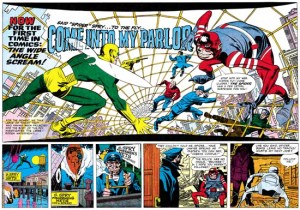
Flash forward just a bit to 1962.
Stan Lee, who’d been with Marvel since the early 1940s, was now Editor-in-Chief, and Jack Kirby his go-to artist. Stan Lee wanted a teenage superhero, as a way to cut out the middleman of the DC superhero model by simply dropping the adult hero altogether and making the sidekick the main character. He approached Kirby with his idea. Kirby pitched him the version of the Silver Spider he and Simon had co-created before adapting it into the Fly.
As explained in Brian Cronin’s Was Superman a Spy?: And Other Comic Book Legends Revealed:
“Lee was interested and aked Kirby to work up a proposal. Lee determined that the superhero Kirby came up with was too traditional, so he gave Kirby’s proposal to Steve Ditko, who remarked to Lee that the premise sounded an awful lot like the Adventures of the Fly series. Lee concurred and asked Ditko to change it around, so Ditko eliminated the web gun, the costume, and the whole wishing-upon-a-ring premise, leaving the character as Peter Parker, the Spider-Man readers know and love.”
So, who created Spider-Man? Lee or Ditko?
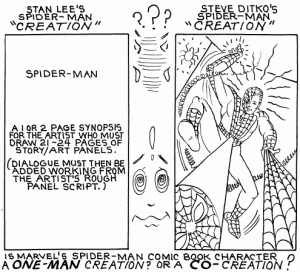
As summarized by Cronin:
After years of disputes with Marvel, Kirby at one point claimed that he created Spider-Man, but Kirby’s memory was not always the greatest, and he would tend to go along with whomever he was talking to at the time. If the interviewer said something like, ‘So you created Spider-Man?’ Kirby wouldn’t contradict them. However, when asked about it later, Kirby clearly stated that he considered Ditko to be the man who developed Spider-Man.
But, wait. Then where did the name Spider-Man came from?
Lee continues to claim he thought up the name. Kirby, when he was still around, disagreed. Then Simon actually disagreed with Kirby and argued that actually way back when they created the Silver Spider together it was he, not Kirby, who created the name Spiderman. If anything, Lee’s contribution on this point might simply have been to insert the hyphen in-between “Spider” and “Man.”
2. Uncle Ben never actually said “With great power, comes great responsibility”
No comic book character has a more perfect summation of their moral code and overall message than Spider-Man’s legendary, “With great power, comes great responsibility.” Although similar to quotes from famous historical figures like Winston Churchill, and Franklin and Theodore Roosevelt, no one appears to have put it quite that way until Stan Lee thought it up for Spider-Man’s inaugural appearance in Amazing Fantasy #15 (1962).
In the Spider-Man story, this quote has always been attributed to Uncle Ben, making it all the more profound of a proclamation coming from the man who died precisely because Peter Parker misused his powers and didn’t stop a crime when he easily could have. In the Sam Raimi film Uncle Ben says it directly to Peter shortly before his death, and the comics Peter have retroactively attributed the quote to Ben.
The problem is Uncle Ben is not the one who actually says it in Amazing Fantasy #15. In fact, no specific character actually utters those lines. Instead, after Parker has delivered Ben’s killer to the police the caption box commenting on the action reads, “And a lean, silent figure slowly fades into the gathering darkness, aware at last that in this world, with great power must also come–great responsibility!”
To be fair, this is kind of a “Beam me up, Scotty” situation where even though our popular version of the famous quote doesn’t exactly match the source material it’s still pretty close.
3. Steve Ditko and Stan Lee stopped speaking to each other while working on Amazing Spider-Man together
Although the who, what, and when of the actual conception of the Spider-Man character remains a matter of debate, what is certain is that Stan Lee (as the writer) and Steve Ditko (as the artist) worked together on Amazing Fantasy #15 and The Amazing Spider-Man #1-#38. The only outside party was Jack Kirby who designed the covers for Amazing Fantasy #15 and Amazing Spider-Man #1. Otherwise, it was just Lee and Ditko, and during their run together most every notable Spider-Man supporting character and villain was introduced, including Doctor Octopus, Green Goblin, Electro, Lizard, Sandman, Aunt May, Betty Brant, Gwen Stacy, Mary Jane Watson (though her actual face was only revealed after Ditko left), Harry Osborn, Flash Thompson, and J. Jonah Jameson.
Their collaboration worked like this: Lee created a plot outline which Ditko was then to animate and greatly embellish, and once Ditko was done with the art Lee would fill in the voice boxes and captions with text.
However, Lee and Ditko were polar opposites in personality, Lee the limelight-seeking showman, Ditko the cold, logical, Ayn Rand-reading Objectivist. Predictably, they didn’t get along and differed over the direction of the comic, with Ditko accusing his collaborator of having the “tendency to take write-in complaints too literally,” as quoted in Sean Howe’s Marvel Comics: The Untold Story.
By the time Amazing Spider-Man #18 arrived in Nov. 1963, Ditko had taken control of the storylines and routinely ignored Lee’s commands to maximize the number of costumed fights, soften the supporting characters, and introduce as many fantastic or mystical elements as possible. #18 was the first one Ditko plotted entirely on his own, and it led Lee to quip in a letters-page description in other Marvel comics that month, “A lot of readers are sure to hate it. So, if you want to know what all the criticism is about, be sure to buy a copy!”
Shortly thereafter, Ditko went to Marvel to voice his displeasure. According to Cronin, “Ditko made a bold request: He wanted credit as the plotter of the book; he wanted extra money that would come from being at least the co-writer of the comic; and, most notably, he did not want to have to speak to Stan Lee at all.”
The book was selling so well they couldn’t turn him down.
Perhaps sensing that this arrangement couldn’t last, Lee had Spider-Man begin to guest star in the pages of Daredevil as a test run to see how that book’s artist, John Romita, would handle Spider-Man should things fall apart with Ditko.
Which is exactly what happened when Ditko turned in his pages for Amazing Spider-Man #38 along with a declaration that it would be his last issue. Ditko has never said exactly why he decided to leave when he did, but it’s since been assumed it was probably a cumulative set of events with the final straw being Marvel’s announcement of a series of planned animated TV shows. The guy had at least co-created if not outright created the most significant portions of the Spider-Man story, and how much would he see in royalties for a TV show about the character? Nothing. The animated Spider-Man show ultimately debuted a year after Ditko quit, and he never received any royalties.
4. The Green Goblin almost didn’t turn out to be Norman Osborn
Who is the Joker to Spider-Man’s Batman? Does he even have one, definitively? When it came time to do the first Sam Raimi Spider-Man film they couldn’t decide the answer to that question. So, for a brief period early on in development rather than pit Spidey against his most iconic villain they were going hedge their bets and include both Green Goblin and Doctor Octopus. Obviously, they ultimately settled on Goblin.
In the comics, he’s the one who brought about Gwen Stacey’s death, and he’s the one who turned out to actually be the split personality of Norman Osborn, the father of Peter’s best friend Harry. He’s now done both of those things on film.
However, when the Goblin was first introduced in the comics he was a total mystery, with his identity only revealed long after he’d been a thorn in Spidey’s side. This was a trick Stan Lee and Steve Ditko had already pulled before with a villain (named, bluntly enough, Big Man) who after multiple issues was revealed to be a colleague of Peter’s from the Daily Bugle. Ditko was okay with having one mysterious villain turn out to be someone Peter knew, but to do so again and so soon afterward strained credibility.
According to Cronin:
“Ditko argued it simply did not make sense that the Green Goblin, a criminal with absolutely zero ties to Spider-Man before Spider-Man starts trying to keep the Goblin from committing crimes, would just happen to be someone that Peter knew in his real life. It was one thing for a criminal mastermind to be someone Peter knew personally, but another? Ditko felt that it strained the readers’ suspension of disbelief to the breaking point.
Lee, on the other hand, felt that if you were going to spend the time to build up to revealing a major character’s identity you simply could not have it be someone who no one has ever seen before.”
When Ditko quit, Lee wasted no time in getting the final word on the matter. He revealed Normal Osborn as the Goblin in the very first post-Ditko issue.
5. Spider-Man paved the way for the famous Green Arrow/Green Lantern drug special
At some point, comic books had to grow up, and while Marvel was more socially aware (what with the X-Men universe pitting the Malcolm X-like Magneto vs. The Martin Luther King, Jr.-like Professor X) it too was criticized as the 60s wore on for not being progressive enough. To many, the tide really turned with DC’s infamous Green Lantern/Green Arrow story in which the sanctimonious Green Arrow discovers that his sidekick is addicted to heroin.
That may never have happened without Spider-Man, though. In 1971, the US Department of Health, Education, and Welfare asked Stan Lee to create an Amazing Spider-Man storyline which addressed drug use, picking Spider-Man since it was among the highest-selling comics in the industry at that time. The problem was the Comics Code Authority, founded in 1954 to police the comics industry, forbade any depiction of drug usage, positive or negative. Even Lee’s “But the US government wants us to do this, you idiots” argument wasn’t enough to sway them. So, Lee’s only option was to publish without the Comics Code Authority seal of approval, something no major comic had done since the Authority began. However, Lee, with the approval of his publisher, risked it, and though you wouldn’t know it from its cover The Amazing Spider-Man #96 depicted Peter Parker discovering best friend Harry Osborn was “a pill-popper!”
It was such a success that the Comics Code Authority overhauled its guidelines to allow negative depictions of drugs. DC had actually already planned out its Green Lantern/Green Arrow drug issue but was not as willing as Lee to run afoul of the Authority. It was only after the guideline changes that they moved forward with their far more vaunted tale of heroin overdose.
6. The black Spider-Man costume that became Venom originated out of a competition for aspiring comic book writers and artists
In 1983, Marvel used The Official Marvel Comics Try-Out Book to invite fans to send in story ideas and drawings. Randy Schueller responded, suggesting a story idea wherein Spider-Man would work with Mr. Fantastic to make his suit stronger than the existing cloth one, and along the way, the suit would be re-designed in all-black. Marvel’s editor in chief Jim Shooter liked the idea enough to buy the story from Schueller for $220, even bringing Schueller in to work with an in-house Marvel writer to draft the story together. Unfortunately, it went nowhere.
That is until a year later when Marvel was in the middle of a crossover event called Secret Wars, which featured most of Marvel’s heroes and set out to introduce a few notable changes to most of the characters throughout the story. Shooter remembered Schueller’s idea for a black suit, and that became the change for Spider-Man in Secret Wars, in which he finds the suit, initially unaware that it is actually a living entity.
7. Venom was originally supposed to be female
Now, imagine if instead of Topher Grace as Eddie Brock being taken over by the Venom symbiote that was a woman. That’s what Venom’s creator, David Michelinie, originally had in mind.
As depicted in Spider-Man 3, Venom is an alien symbiote which initially attached itself to Peter Parker, absorbing all of his powers in the process. Instead of jumping from Peter to Eddie Brock, though, its second human host was meant to be a woman.
According to Cronin:
“Michelinie’s original idea was to involve a pregnant woman who was rushing to the hospital to deliver her baby. They would be hailing a cab in the middle of New York while Spider-Man was fighting a supervillain. A cab driver, distracted by the fight, would accidentally run over the woman’s husband. He would die in front of her just as she goes into labor. She would end up losing both her child and her sanity at the same time. After she got out of the mental institution, she would harbor an intense hatred for Spider-Man, making her a perfect host for the alien costume.”
So, what happened? Too dark? His pitch was turned down for being too depressing, right?
Nope:
“When Michelinie pitched the idea to Amazing Spider-Man editor Jim Salicrup, however, Salicrupt felt that readers simply would not believe that a woman could be the physical threat Venom needed to be, even a woman with enhanced alien strength.”
8. Spider-Girl was saved from cancellation by a fake letter from a young female fan
In 1998, Marvel introduced Spider-Girl, Spider-Man’s daughter, as part of series of comics devoted strictly to the sons and daughters of famous Marvel heroes. Spider-Girl was the only one who survived, anchoring her own book for 3 years until Marvel decided to cancel it.
Then Marvel editor-in-chief Joe Quesada received a fan letter from a little girl pleading with him not to cancel Spider-Girl because there were so few superheroes for little girls, and Spider-Girl was her favorite. There were other fans who were writing in at the time with your standard “Save Spider-Girl” petitions, but the heartfelt letter (and its indication of an untapped market/demographic) resonated with Quesada. So, Marvel reprinted the older Spider-Girl stories in a new line aimed at girl readers.
Quesada wanted to celebrate the news by arranging a meeting with the girl who wrote the letter, but then he found out there was no little girl at all. The letter had been written by an older male fan from the hypothetical point of view of his infant daughter should she be given the chance to grow up and read Spider-Girl.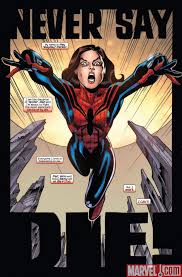
Sources: Brian Cronin’s Was Superman a Spy?: And Other Comic Book Legends Revealed; Sean Howe’s Marvel Comics: The Untold Story, GreenGoblinsHideOut
Use the following links to check out our other Spider-Man history articles:

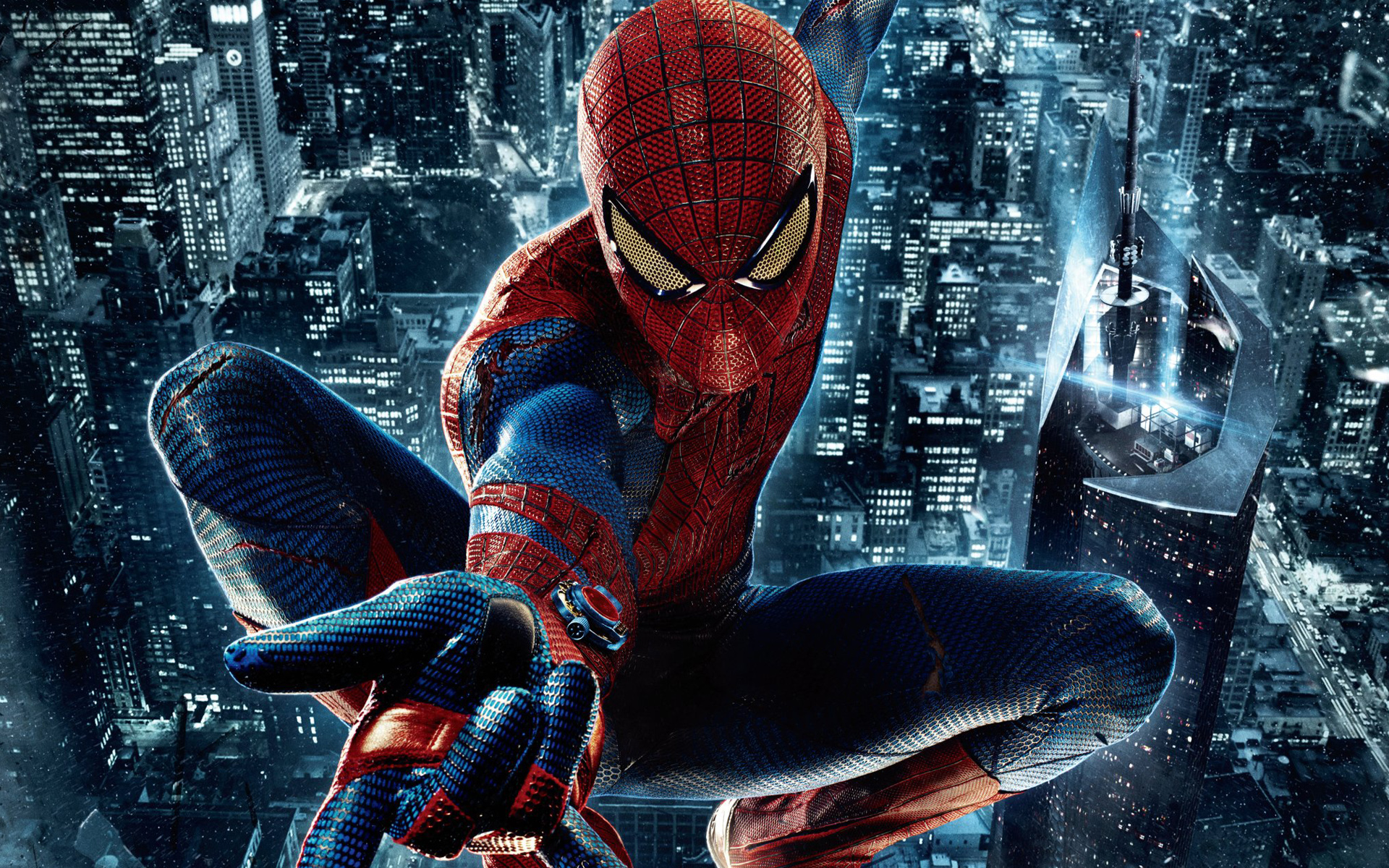
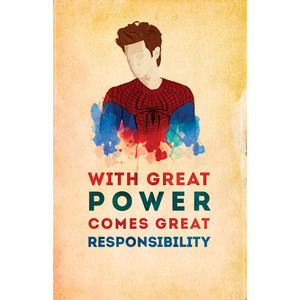
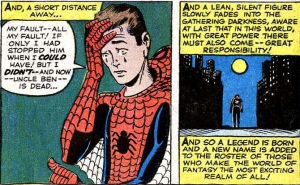
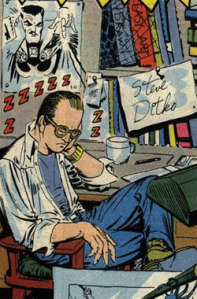
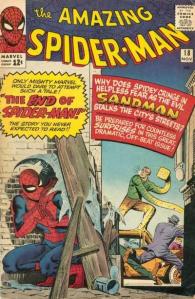
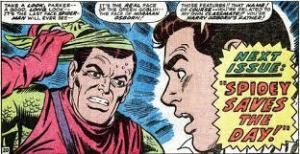
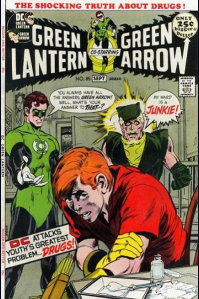
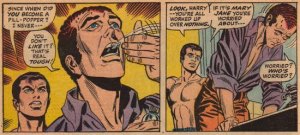
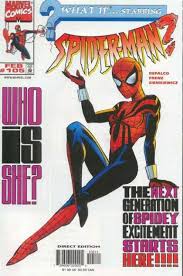
Major errors in this article:
1) Kirby’s Spiderman was not rejected for being a “re-worked Captain America.” In fact, Kirby’s Spiderman was ACCEPTED by Lee, or the original 5 Kirby pages would not have been given to Ditko to ink.
Ditko noticed the similarities to the Fly and it was at that point that the Kirby version was scrapped and the strip was given to Ditko.
2) Ditko has NEVER said that Lee came up with the name Spiderman. Ditko is always very careful not to make claims when he has no personal knowledge. He has been quite clear that he doesn’t know whether it was Lee or Kirby who came up with any particular elements.
And in any event the earlier S&K Spiderman logo makes it clear the name did not come from Lee. Unless you consider it his because he added the hyphen.
3) “Lee is probably who thought of having Spider-Man get his powers from a radioactive spider bite.” Possibly, but we literally have no idea. There is simply no evidence at all to credit that detail to Lee rather than Ditko or even Kirby. If it is “probably” Lee…why?
4) “Steve Ditko wouldn’t speak to Stan Lee.” Lee’s claim is presented as fact; Ditko states it is Lee who quit speaking to him.
Artist Wally Wood left Marvel at the same time as Ditko and also claims his relationship with Lee soured when he asked for pay and credit for writing.
No, Ditko’s claim isn’t proof…but neither is Lee’s.
5) “Ditko’s plan for the Green Goblin was to introduce Norman as Harry’s father to function as a decoy, the guy you’re supposed to think might be the Goblin. Then Spider-Man would discover the Goblin was someone he didn’t know.”
Um…no. Ditko is adamant that is was Osborn all along and that he wrote the stories so that it had to be Osborn. In fact, Ditko had done the “nobody” as villain story already in Spider-Man #26.
Thanks for listing some of these points. There are so many factual errors in this article regarding the Lee-Ditko Spider-Man era that I don’t even know where to begin.